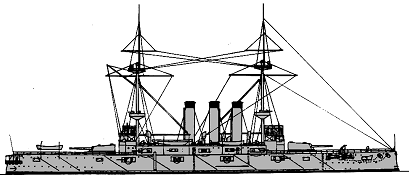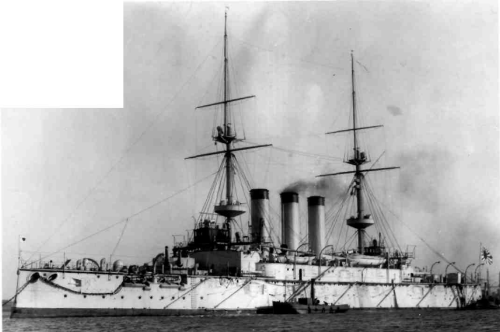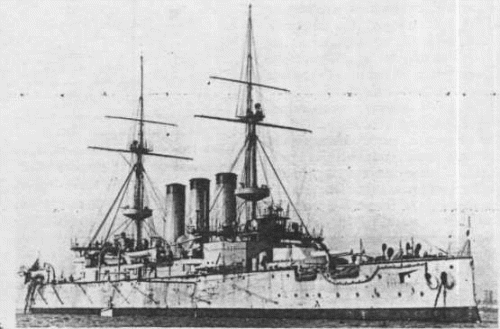

Shikishima 1901
| Name | No | Yard No | Builder | Laid down | Launched | Comp | Fate |
| 敷島 [Shikishima] | Thames Iron Wks, Blackwall, UK | 29.3.1897 | 1.11.1898 | 26.1.1900 | transport 4.1923 | ||
| 初瀬 [Hatsuse] | 680 | Armstrong, Elswick, UK | 10.1.1898 | 27.6.1899 | 18.1.1901 | sunk 15.5.1904 |
|
Displacement normal, t |
Shikishima: 14850 Hatsuse: 15000 |
|
Displacement full, t |
Shikishima: 15453 Hatsuse: 15255 |
|
Length, m |
Shikishima: 121.9 pp 126.5 wl 133.5 oa Hatsuse: 121.9 pp 126.5 wl 134.0 oa |
|
Breadth, m |
Shikishima: 23.0 Hatsuse: 23.4 |
|
Draught, m |
8.29 |
|
No of shafts |
2 |
|
Machinery |
2 VTE, 25 Belleville boilers |
|
Power, h. p. |
14500 |
|
Max speed, kts |
18 |
|
Fuel, t |
Shikishima: coal 1722 Hatsuse: coal 1900 |
| Endurance, nm(kts) | 5000(10) |
|
Armour, mm |
Harvey nickel steel - belt: 229 - 102, bulkheads: 356 - 152, upper belt: 152, casemates: 152 - 51, deck: 102 - 51, barbettes: 356 - 203, turrets: 254 - 203, CT: 356 sides, 76 roof |
|
Armament |
Shikishima: 2 x 2 - 305/40 Armstrong G, 14 x 1 - 152/40 Armstrong Z, 20 x 1 - 76/40 Armstrong N, 6 x 1 - 47/40 3pdr Hotchkiss Mk I, 6 x 1 - 47/30 21/2pdr Hotchkiss Mk I, 5 - 450 TT (1 bow, 4 beam) Hatsuse: 2 x 2 - 305/40 Armstrong G, 14 x 1 - 152/40 Armstrong Z, 20 x 1 - 76/40 Armstrong N, 8 x 1 - 47/40 3pdr Hotchkiss Mk I, 4 x 1 - 47/30 21/2pdr Hotchkiss Mk I, 4 - 450 TT (beam) |
|
Complement |
Shikishima: 836 Hatsuse: 741 |
Project history: These two ships, ordered under the 1896 Ten Year Naval Expansion Programme, were built to a design by G C Macrow and were an improved type of British Majestic. The armament was identical to that of the Fuji class and the machinery was similar, enabling the classes to act together as a homogeneous unit. The ships were built on the bracket frame system, the wing passages being used for extra bunkerage. Amidships there was a double bottom and the ships had a total of 261 watertight compartments, The Harvey NS armour was also improved, a new type of armoured deck, first introduced in the British Renown, being fitted. This deck, instead of resting flat on top of the armoured belt, sloped up from the bottom of the belt, thereby increasing vertical protection, any shell-penetrating the main belt having also to pass through the slope of the deck before reaching the machinery spaces. By providing, in effect, two belts spaced apart, the thickness of the main belt could be reduced, saving weight, which was used to extend the belt and also to provide a thinner belt of armour above the main belt amidships, slightly longer in the Hatsuse than in the Shikishima.
On completion the Halsuse represented the Emperor of Japan at Queen Victoria's funeral before sailing to join the Japanese Fleet.
Ship protection: Main belt placed on full ship length and was 2.4m high, its thickness amidships was 229mm (127mm at lower edge) decreasing consequently to 178 and 102mm near ship ends. It connected with main gun barbettes by 356-152mm bulkheads. Upper 66m belt was 152mm thick and 2.3m high. Casemates had 152mm face and 51mm rear armor. Barbettes had 356mm thickness over and 203mm under main deck. Turrets had 254mm faces, 203mm sides and rears and 102mm roofs. CT had 356mm sides and 76mm roof. Fore torpedo room had 152mm protection. 51mm armoured deck over citadel connected with lower edge of main belt by 102mm slopes. It had turtleback form outside barbettes and had 76-51mm thickness.
Modernizations: None.
Naval service: Both ships were present at the bombardment of Port Arthur on 9 February 1904, and the subsequent blockade, the Hatsuse striking a Russian mine there on 15 May 1904. She was taken in tow by Asahi but struck a second mine and sank almost immediately when her magazine exploded. Shikishima was present at both the Battle of the Yellow Sea and the Battle of Tsushima. She was classed as a coast defence ship in September 1921 and then disarmed and immobilised under the terms of the Washington Treaty. From 1923 she served as a seamen's training ship, then as hulk and was scrapped at Sasebo in 1947.

Shikishima

Hatsuse 1901
Many thanks to Wolfgang Stöhr for additional information on this page.
© Ivan Gogin, 2008-14